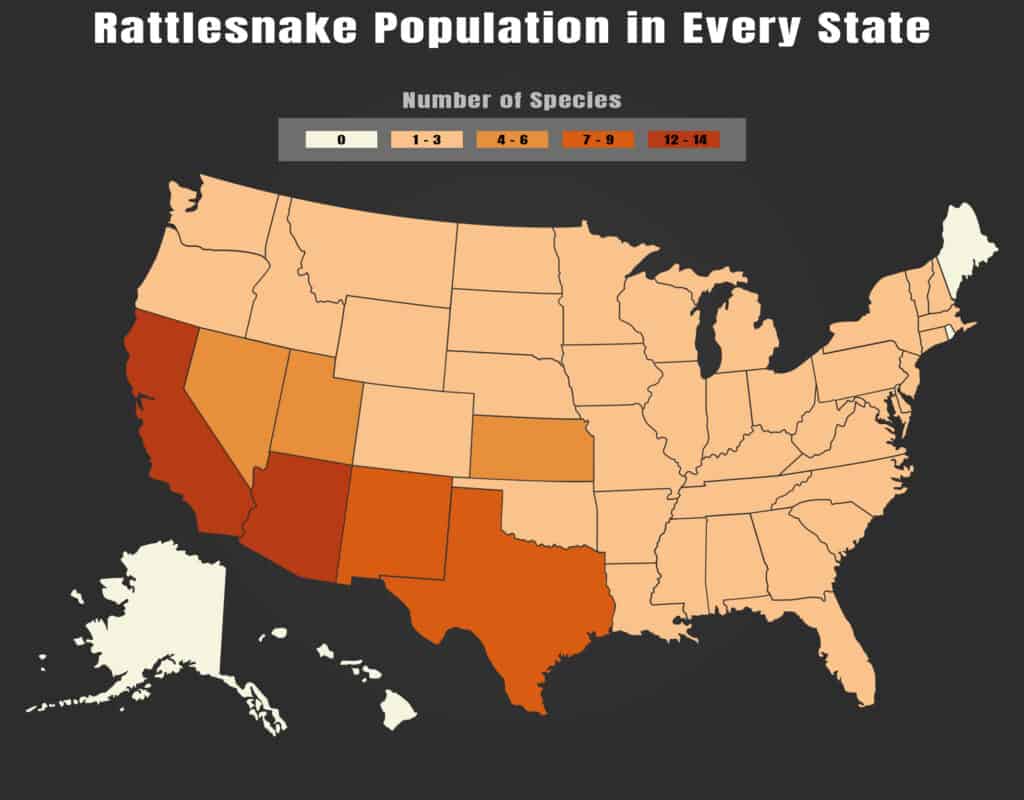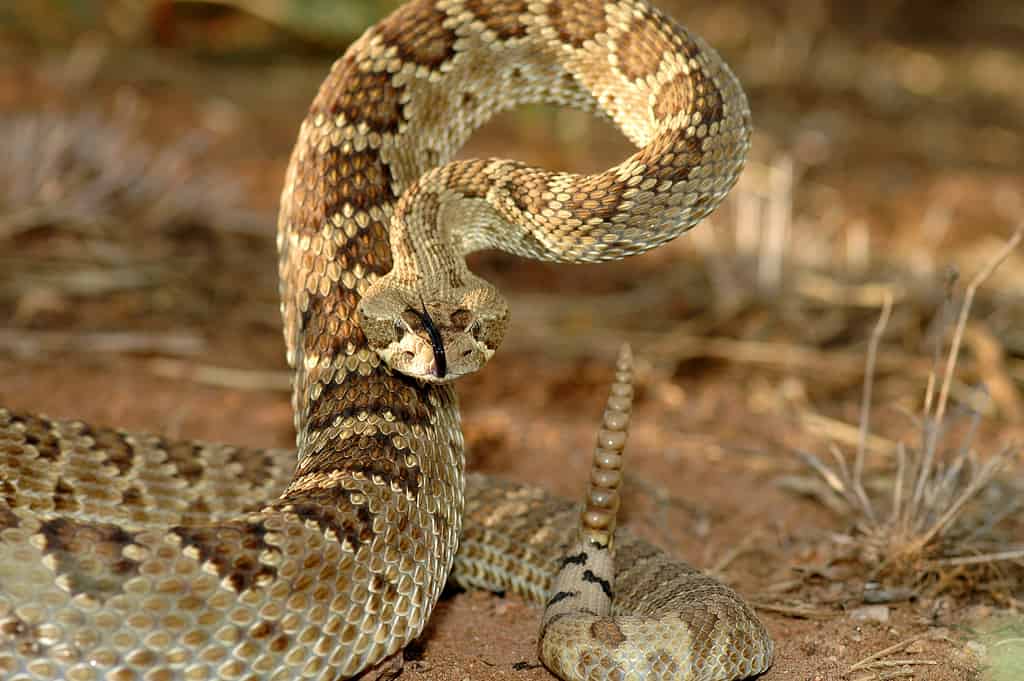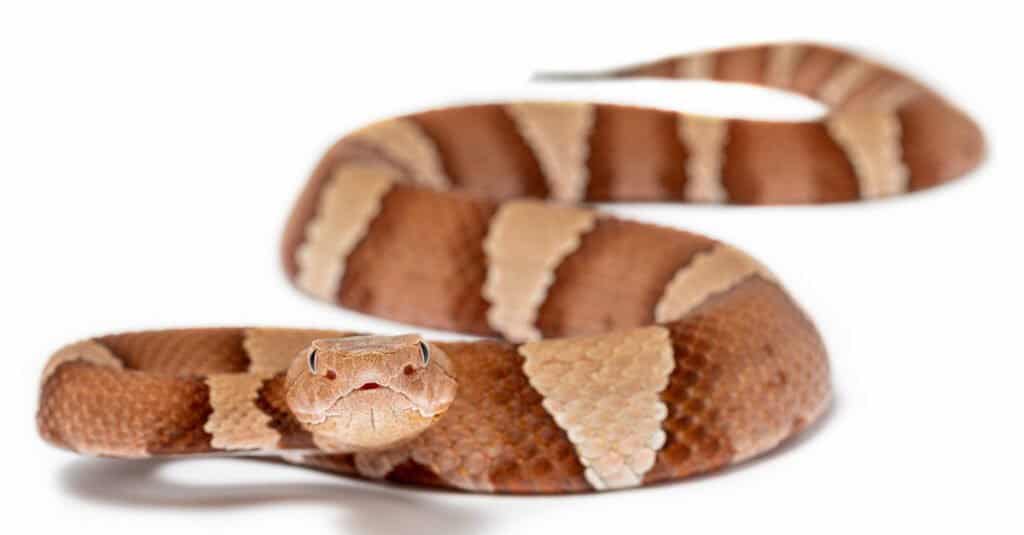Key Points:
- Rattlesnakes are venomous pit vipers native to the United States.
- There are 20 species of rattlesnakes in the country, plus several subspecies.
- Arizona has the most species of rattlesnake, with 14 different types.
Rattlesnakes are native to the United States, but how many species does each state boast? If you have ever wondered what the rattlesnake population is by the state, here is a comprehensive list.

Say Hello to the Rattler
The warning rattle of this pit viper has made it one of the most famous snakes in the world. These snakes live in most states, and their venom can be highly toxic to humans. Fortunately, they are shy snakes, and human encounters are rare. Rattlesnakes are critical members of their ecosystems.
It is always smart to be on the lookout for snakes when you’re hiking, and it’s especially smart to heed a hissing, rattling snake. If you see one, don’t approach it or antagonize it. It will probably leave you alone if you do the same.
Where Do Rattlesnakes Live?
There are about 20 species of this snake native to the U.S., with about as many subspecies. Like most snakes, rattlers prefer warm, sunny weather and dense vegetation. They live in deserts, mountainous regions, forests, and prairies.
What Do Rattlesnakes Eat?
Rattlesnakes are carnivores that eat mice, voles, chipmunks, and other small mammals. Like all snakes, they are extremely important for controlling rodent populations.
What Is the Rattlesnake Population in the United States?
Surprisingly, there are no official numbers available for snake species. Although we know snake populations are declining in the United States and globally, we don’t actually know how many there are.
Scientists are working on ways of improving their ability to monitor snake populations, but reliable estimates are currently not available. In this list, we’ve compiled all the rattlesnake species that are native to each state.
Rattlesnake Species by State
Alabama: 3
Alabama is home to three rattler species:
- Pygmy
- Timber Rattlesnake
- Eastern diamondback
Alaska: 0
Alaska has no rattlesnakes. In fact, it has no snake species at all.
Arizona: 14
With 14 species, Arizona has more types of rattlesnakes than any other state. They are:
- Desert massasauga
- Mojave desert rattlesnake
- Sidewinder
- Grand Canyon
- Arizona black
- Great Basin
- Tiger
- Banded rock
- Western diamondback
- Twin-spotted
- Southwestern speckled
- Arizona ridge-nosed
- Northern black-tailed
- Prairie rattlesnake

An adult Mojave rattlesnake in a defensive stance.
©Shoemcfly/iStock via Getty Images
Arkansas: 2
- Western diamondback
- Timber
California: 12
California’s native rattlers are the:
- Western diamondback
- Sidewinder
- Mojave Desert
- Colorado desert sidewinder
- Southwestern speckled
- Southern Pacific
- Panamint
- Northern Mojave
- Mojave green
- Great basin
- Red diamond
- Northern Pacific.
Colorado: 3
- Western massasauga
- Prairie
- Midget-faced
Connecticut: 1
The state’s only rattler is the timber rattlesnake, which is also endangered in the state.
Delaware: 1
The timber rattlesnake is the only one in this state.
Florida: 3
Florida has many snakes, but only three of its species are rattlers:
- Pygmy
- Eastern diamondback
- Timber.
Georgia: 3
- Timber
- Eastern diamondback
- Pygmy
Hawaii: 0
Hawaii has no rattlesnakes.
Idaho: 2
- Western, which is another name for the prairie rattlesnake
- Pacific
Illinois: 2
- Massasagua
- Timber rattlesnake
Indiana: 2
- Eastern massasauga
- Timber
Iowa: 3
- Timber
- Prairie
- Eastern massasauga
Kansas: 4
- Western diamondback
- Prairie
- Timber
- Pygmy
Kentucky: 2
The state has more than 30 snake species, but only two are rattlesnakes:
- Pygmy
- Timber.
Louisiana: 3
Of its three species, the canebrake is the most common rattler in Louisiana — and the most dangerous. It can grow up to 8 feet long and is extremely venomous.
- Eastern diamond
- Pygmy
- Canebrake
Maine: 0
Maine once had timber rattlesnakes, but it no longer does.
Maryland: 1
With the copperhead, the timber rattlesnake is one of only two Maryland snakes whose venom is dangerous to humans. The state has other venomous snakes, but their venom is not strong enough to harm humans.
Massachusetts: 1
The timber is the only rattlesnake in the state. It is classed as critically endangered in Massachusetts.
Michigan: 1
The eastern massasauga is the state’s only venomous snake.
Minnesota: 1
- Timber
Mississippi: 3
- Pygmy
- Eastern diamondback
- Canebrake
Missouri: 3
- Timber
- Western pygmy
- Eastern massasauga
Montana: 1
The western rattlesnake or prairie rattlesnake is the only venomous snake in Montana.
Nebraska: 3
- Prairie
- Timber
- Western massasauga
Nevada: 5
- Mojave Desert
- Sidewinder
- Western diamondback
- Speckled southwestern
- Great Basin
New Hampshire: 1
- Timber
New Jersey: 1
- Timber
New Mexico: 7
- Western diamondback
- Animas ridge-nosed rattlesnake
- Mojave Desert
- Banded rock rattlesnake
- Mottled rock
- Northern black-tailed
- Prairie rattlesnake
New York: 2
- Timber rattlesnake
- Massasauga rattlesnake
North Carolina: 3
- Eastern diamondback rattlesnake
- Pygmy rattlesnake
- Timber rattlesnake
North Dakota: 1
- Prairie rattlesnake
Ohio: 2
- Massasauga rattlesnake
- Timber rattlesnake
Oklahoma: 3
- Western massasauga rattlesnake
- Western pygmy rattlesnake
- Prairie rattlesnake
Oregon: 3
- Western rattlesnake
- Northern Pacific rattlesnake
- Great Basin rattlesnake
Pennsylvania: 2
- Eastern massasauga rattlesnake
- Timber rattlesnake
Rhode Island: 0
There are no rattlesnakes in the state.
South Carolina: 2
- Timber rattlesnake
- Canebrake rattlesnake
South Dakota: 1
- Prairie rattlesnake
Tennessee: 2
- Timber rattlesnake
- Pygmy rattlesnake
Texas: 9
With lots of land and many different ecosystems, it’s natural that Texas should have a good variety of rattlesnakes. Its nine are:
- Western diamondback
- Timber
- Desert massasauga
- Mojave Desert
- Prairie
- Western massasauga
- Banded rock
- Blacktail
- Mottled rock
Utah: 6
Utah has 30 snake species, and six of them are rattlesnakes. Its species include the Hopi rattlesnake, which is a subspecies of the prairie rattlesnake.
- Mojave Desert
- Speckled southwestern
- Midget-faced
- Hopi rattlesnake
- Great Basin
- Mojave Desert sidewinder
Vermont: 1
The timber rattlesnake is the state’s only venomous snake and is critically endangered. It is listed as a Species of Greatest Conservation Need in the state’s Wildlife Action Plan.
Virginia: 1
With the cottonmouth and copperhead, the timber rattlesnake is one of three venomous snakes that are native to Virginia.
Washington: 1
The only rattlesnake in this state is the western rattlesnake.
West Virginia: 1
The timber rattlesnake is West Virginia’s official state reptile. It is listed as a species deserving special protection under state law.
Wisconsin: 2
- Timber
- Eastern massasauga
Wyoming: 2
Wyoming’s two rattler species are the state’s only venomous snakes:
- Prairie
- Midget-faced.
Summary of Rattlesnake Population By State
Here’s a table showing at a glance which states are inhabited by rattlesnakes and what types are present.
| Number | State | Number of Rattlesnake Species | Type of Rattlesnakes |
|---|---|---|---|
| 1 | Alabama | 3 | Pygmy, Timber, Eastern diamondback |
| 2 | Alaska | 0 | |
| 3 | Arizona | 14 | Desert massasauga, Mojave desert, Sidewinder, Grand Canyon, Arizona black, Great Basin, Tiger, Banded rock, Western diamondback, Twin-spotted, Southwestern speckled, Arizona ridge-nosed, Northern black-tailed, Prairie |
| 4 | Arkansas | 2 | Western diamondback, Timber |
| 5 | California | 12 | Western diamondback, Sidewinder, Mojave Desert, Colorado desert sidewinder, Southwestern speckled, Southern pacific, Panamint, Northern Mojave, Mojave green, Great basin, Red diamond, Northern Pacific |
| 6 | Colorado | 3 | Western massasauga, Prairie, Midget-faced |
| 7 | Connecticut | 1 | Timber |
| 8 | Delaware | 1 | Timber |
| 9 | Florida | 3 | Pygmy, Eastern diamondback, Timber |
| 10 | Georgia | 3 | Timber, Eastern diamondback, Pygmy |
| 11 | Hawaii | 0 | |
| 12 | Idaho | 2 | Western/Prairie, Pacific |
| 13 | Illinois | 2 | Massasagua, Timber rattlesnake |
| 14 | Indiana | 2 | Eastern massasauga, Timber |
| 15 | Iowa | 3 | Timber, Prairie, Eastern massasauga |
| 16 | Kansas | 4 | Western diamondback, Prairie, Timber, Pygmy |
| 17 | Kentucky | 2 | Pygmy, Timber |
| 18 | Louisiana | 3 | Eastern diamondback, Pygmy, Canebrake/Timber |
| 19 | Maine | 0 | |
| 20 | Maryland | 1 | Timber |
| 21 | Massachusetts | 1 | Timber |
| 22 | Michigan | 1 | Eastern massasauga |
| 23 | Minnesota | 1 | Timber |
| 24 | Mississippi | 3 | Pygmy, Eastern diamondback, Canebrake/Timber |
| 25 | Missouri | 3 | Pygmy, Eastern diamondback Canebrake/Timber |
| 26 | Montana | 1 | Western/Prairie |
| 27 | Nebraska | 3 | Prairie, Timber, Western massasauga |
| 28 | Nevada | 5 | Mojave Desert, Sidewinder, Western diamondback, Speckled southwestern, Great Basin |
| 29 | New Hampshire | 1 | Timber |
| 30 | New Jersey | 1 | Timber |
| 31 | New Mexico | 7 | Western diamondback, Animas ridge-nosed, Mojave Desert, Banded rock, Mottled rock, Northern black-tailed, Prairie |
| 32 | New York | 2 | Timber rattlesnake, Massasauga |
| 33 | North Carolina | 3 | Eastern diamondback, Pygmy, Timber |
| 34 | North Dakota | 1 | Prairie |
| 35 | Ohio | 2 | Massasauga, Timber |
| 36 | Oklahoma | 3 | Western massasauga, Western pygmy, Prairie |
| 37 | Oregon | 3 | Western, Northern Pacific, Great Basin |
| 38 | Pennsylvania | 2 | Eastern massasauga, Timber |
| 39 | Rhode Island | 0 | |
| 40 | South Carolina | 3 | Timber, Eastern diamondback, Pygymy |
| 41 | South Dakota | 1 | Prairie |
| 42 | Tennessee | 2 | Timber, Pygmy |
| 43 | Texas | 9 | Western diamondback, Timber, Desert massasauga, Mojave Desert, Prairie, Western massasauga, Banded rock, Blacktail, Mottled rock |
| 44 | Utah | 6 | Mojave Desert, Speckled southwestern, Midget-faced, Hopi rattlesnake, Great Basin, Mojave Desert sidewinder |
| 45 | Vermont | 1 | Timber |
| 46 | Virginia | 1 | Timber |
| 47 | Washington | 1 | Western |
| 48 | West Virginia | 1 | Timber |
| 49 | Wisconsin | 2 | Timber, Eastern massasauga |
| 50 | Wyoming | 2 | Prairie, Midget-faced |
Bonus: What State Has the Most Snake Attacks?

The venomous copperhead snake is among the snakes responsible for snake bites in North Carolina.
©Scott Delony/Shutterstock.com
There’s no denying that there are numerous rattlesnake species across the U.S. But some states could arguably be more dangerous to live in, based on the annual number of snake bites that occur. What state ranks the highest in snake bites? That would be North Carolina. This southeastern state’s bite rate is 157.8 bites per million population per year. How does that average out? Well, the population as of 2021 was a little over 10 million (10.55 to be exact). If we were to just figure it off of 10 million, that would mean that there are roughly 1,580 reported snake bites per year.
The top 6 states for reported snake bites are as follows:
- North Carolina–157.8 bites per million
- West Virginia–105.3 bites per million
- Arkansas–92.9 bites per million
- Oklahoma–61 bites per million
- Virginia–48.7 bites per million
- Texas–44.2 bites per million
In North Carolina, there are 6 different kinds of venomous snakes: copperhead, cottonmouth, timber rattlesnake, pigmy rattlesnake, eastern diamondback rattlesnake, and eastern coral snake. In 2019, 92 people were bitten by venomous snakes in that state.
The photo featured at the top of this post is © Rusty Dodson/Shutterstock.com
Discover the "Monster" Snake 5X Bigger than an Anaconda
Every day A-Z Animals sends out some of the most incredible facts in the world from our free newsletter. Want to discover the 10 most beautiful snakes in the world, a "snake island" where you're never more than 3 feet from danger, or a "monster" snake 5X larger than an anaconda? Then sign up right now and you'll start receiving our daily newsletter absolutely free.
Thank you for reading! Have some feedback for us? Contact the AZ Animals editorial team.






